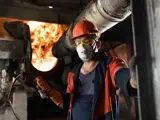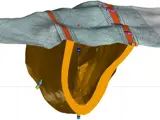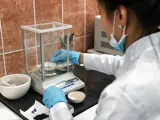Balasausqandiq Deposit
Discovered in the 1940s, the Balasausqandiq deposit is a very large black-shale deposit containing vanadium and valuable by-products. This deposit is unlike the majority of other vanadium deposits in the world, either in production or proposed, in that it is not comprised of vanadiferous titano-magnetite and is amenable to a processing method which is lower in both capital and operating costs.
The current mineral resource estimate for the deposit amounts to some 33m tonnes of ore from only the first (of seven known) ore bodies within the Company’s mining licence area.
The deposit is expected to be large enough to eventually support an operation to treat up to 10m tonnes of ore per year, producing some 55,000 tonnes of vanadium pentoxide per year. However, to avoid oversupply to the market, engineering risks, and to reduce shareholder dilution, the Company plans to develop the deposit more slowly, in steps that are more in tune with both the natural expansion of the vanadium market and at a pace which allows the later stages of the project to be substantially financed from the earnings of the earlier stages. This relatively slow development plan can be revised if there is a significant increase in demand, for example, for vanadium redox flow batteries for energy storage.
A two-phase development is currently planned, starting at 1.65m tonnes of ore per year (Phase 1) and rising to 5m tonnes of ore per year (Phase 2).
The 1.65m tonnes per year initial development followed by a 3.35m tonnes per year expansion is an integrated plan aimed at limiting financial, engineering and market risk, whilst still benefiting from the economies of scale of the large deposit size. Further expansions beyond the current plans are possible.
Carbon
While the main focus of the project is vanadium, the Balasausqandiq ore contains several valuable by-products which are commercially viable for the Company to recover and process, including molybdenum, uranium and carbon. The most significant of those by-products is carbon, which makes up more than 8% of the ore and is in a form similar to carbon black.
Studies have been carried out on the enrichment of the carbon from the ore, following the recovery of the vanadium and other metals, and the potential use of this material as a substitute for carbon black in the production of rubber, tyres in particular. For this purpose a 40% carbon concentrate can be produced by flotation, with the remaining material, principally comprising silica. An alternative use of the carbon-silica tailings for making ferro-silicon has been successfully tested.
The Company has completed testing on the carbon concentrate and the results have confirmed the suitability of the concentrate for use in tyre rubber manufacture and other rubber applications.
The testing undertaken has shown that the carbon concentrate can be successfully used as a partial substitute for conventional carbon black filler in a passenger car tyre sidewall compound formulation. The results show that with a substitution of up to 10% it was possible to produce compounds with similar physical properties to that of the carbon black control formulation. In particular a sample comprised of 90% carbon black, N660 grade, and 10% carbon concentrate from the Balasausqandiq ore yielded properties similar to those of the control compound and would, therefore, be expected to deliver similar performance in a tyre.
Whilst the data did show that the carbon concentrate, when substituted at levels greater than 10%, produced slightly less of a reinforcing effect in the rubber compound than conventional carbon black, some potential advantages in physical properties were identified which could lead to improvements in tyre rolling resistance and sidewall damage resistance.
The ore also contains rare earth elements and aluminium but recovery is not currently considered to be economically viable.
Mineral resource
The Balasausqandiq deposit is very large, having seven known ore bodies identified by at least surface trenching.
A mineral resource estimate for OB1 shows an Indicated Mineral Resource of 32.89m tonnes at 0.62% vanadium pentoxide at a 0.4% cut-off grade (203,634 tonnes of vanadium pentoxide metal content)
|
Class |
Weathering |
Mass (Million Tonnes) |
Average Value |
Material Content |
||||||
|---|---|---|---|---|---|---|---|---|---|---|
|
V2O5 |
Mo |
U |
C |
V2O5 |
Mo |
U |
C |
|||
|
Indicated Resource |
Oxide |
1.56 |
0.67 |
0.0139 |
0.0047 |
7.16 |
10,560 |
216 |
73 |
112, |
|
Transitional |
1.25 |
0.66 |
0.0138 |
0.0045 |
7.17 |
8,260 |
172 |
56 |
89, |
|
|
Fresh-sulphide |
30.08 |
0.61 |
0.0150 |
0.0052 |
8.82 |
184,814 |
4,523 |
1,554 |
2,655, |
|
|
Total |
32.89 |
0.62 |
0.0149 |
0.0051 |
8.68 |
203,634 |
4,911 |
1,683 |
2,857, |
|
OB2, 3 and 4 have been drilled and are awaiting assays. An MRE for these ore bodies will be issued by SRK in due course. At present, too little is known about OB5, 6 and 7 for any quantitative assessment to be made, however, drilling and assaying on these ore bodies will likely take place following the commissioning of Phase 1 of the project.
Feasibility study
The feasibility study on the Balasausqandiq deposit for Phase 1 of the project is ongoing. The metallurgical processing elements are being conducted by Tetra Tech and the remainder by SRK.
We expect to be able to announce the feasibility study into Phase 1 of the project during Q2 2025, with Phase 2 following afterwards.
Infrastructure
The project benefits from a significant amount of existing infrastructure, including high voltage electrical lines, a surfaced access road, local telecommunications and a regional railway. There is also site-specific infrastructure developed for the purposes of the existing operation, including a connection to a 110 kV power line and mobile telephone and electronic communications.
The mine and processing site is situated 70 km from the town of Shieli with an existing surfaced and well-maintained road. Shieli itself, where the Company maintains offices, storage and workshops, is situated on the main rail and motorway corridor that links Western Europe through Kazakhstan with East-coast China. The international airport of Kyzylorda is located some 120 km from Shieli.





